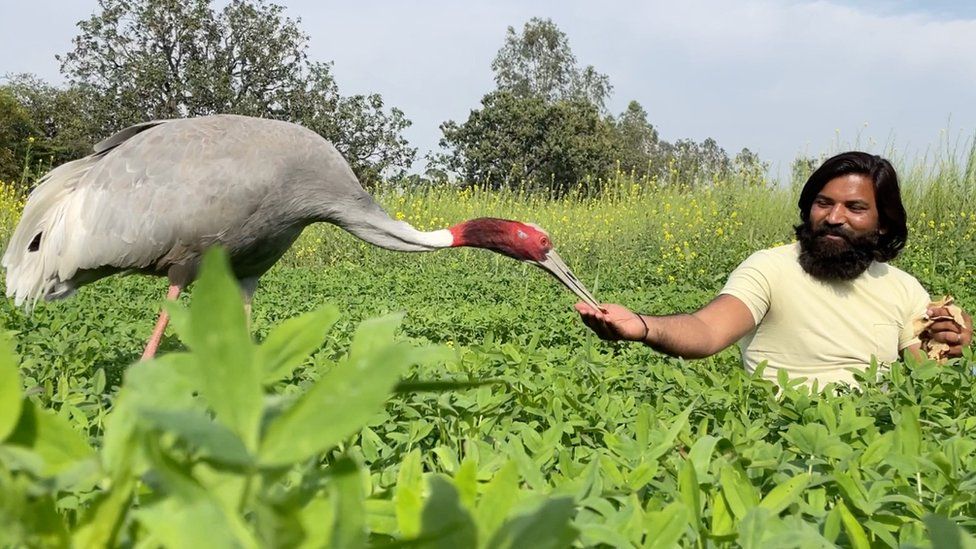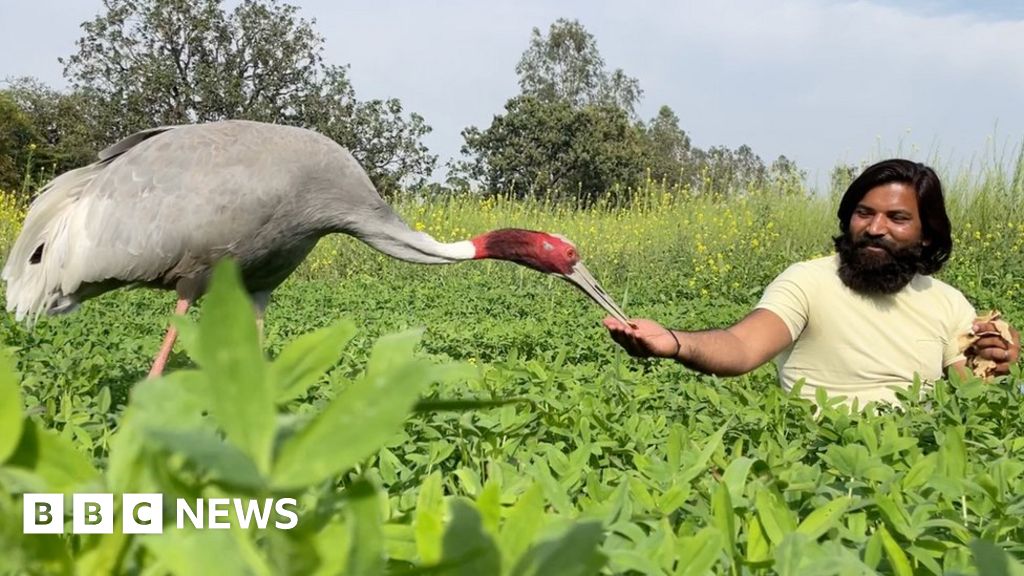This video can not be played
To play this video you need to enable JavaScript in your browser.
A rare Sarus crane has been confiscated from the Indian man who nursed it back to health from injury after the story of their bond made headlines.
Officials in Uttar Pradesh moved the protected bird – featured in a recent BBC video – to a wildlife sanctuary.
The farmer who found it in his field a year ago said he’d expected it to fly back to the wild – but it never did.
Reports say the crane flew away from its new home after being moved but sanctuary officials deny it is missing.
Local media reported it had been found by villagers who were seen feeding a crane in a video that went viral. But officials denied the reports, saying the crane remained “within the boundaries” of Samaspur bird sanctuary where it was taken.
“It’s not been confined to a room, but has been released in the sanctuary. It’s finding food on its own, but we are also giving it wheat, bread and water,” forest official Rupesh Srivastava told BBC Hindi.
Uttar Pradesh is home to at least 17,000 Sarus cranes, where it is the official “state bird”. Under Indian law it’s illegal for individuals to keep Sarus cranes or even feed them.
Farmer Mohammad Arif, who found the crane last year, said officials arrived at his home on Tuesday afternoon, and told him the bird could no longer stay with him. They had received orders from the wildlife department to confiscate it, he said.
“I don’t know about wildlife laws. I’m a farmer. But if I had caged it, tied it up and hadn’t allowed it to go anywhere, then I could understand the forest department would want to take it away,” he said.
“But you saw that it flew around and came and went as it pleased. Did you ever see that I was constricting its movements?”
In the video by BBC Hindi earlier this month Mr Arif explained he thought the bird would leave once its injuries healed, but it stayed and rarely left his side.
“It flies away on some days, but always returns by sunset,” he’d said.

Mr Arif said that he followed the vehicle carrying the crane to the Samaspur sanctuary on Tuesday.
“But then they chased me away. I don’t know what condition they have kept it in. They must have locked it up, otherwise it would have come back to me,” he said, adding: “I want it to be set free. I know it will return to me.”
The story has set off a political spat, with the leader of the state’s main opposition party accusing the government of a vendetta. Akhilesh Yadav told a press conference on Wednesday that the crane had been confiscated after he visited Mr Arif and was pictured alongside the bird.
There’s been no response from the state government on whether that’s true.
But – politics aside – wildlife expert Samir Kumar Sinha, who heads the Sarus Crane Conservation Project at the Wildlife Trust of India (WTI), said moving the bird to a sanctuary was the right thing to do.
“Conservation and compassion are two different things. You can rescue a bird in distress but you have to hand it over to the custodians of law.”
Mr Sinha said not doing so could encourage others to keep wild animals as pets. “Wild animals have wild instincts. What happens if the bird attacks someone?”
The Sarus crane is the tallest of all flying birds, growing to a height of up to six feet (1.8 m). It thrives in the wetlands of Uttar Pradesh where most of India’s crane population lives.
Mr Sinha says the bird’s habitat, which once stretched from the western tip of India to cover the entire Gangetic plane, has shrunk and the crane is now found only in small pockets in Rajasthan, Gujarat, Madhya Pradesh and Bihar states.
The WTI, which has partnered with the state authorities to safeguard wetlands, is working with local volunteers from farms and villages to protect crane nests as birds often lay eggs in their fields.
“If you really want to help the crane, then the right thing is to protect the wetlands which are the bird’s habitat. And then let nature take its course,” says Mr Sinha.

Read more India stories from the BBC:


